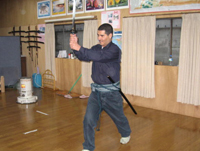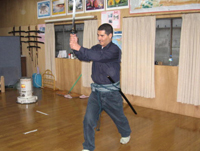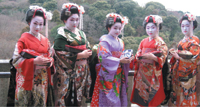
A Yemeni in the Land of the Rising Sun [Archives:2008/1125/Last Page]
January 28 2008
 |
 |
For The Yemen Times
mshamsaddin@yahoo.com
Despite the fact that I visited Japan from 2005 to 2006, my memories and impressions of the country remain fresh in my mind. I spent nine months in various Japanese cities, but primarily in Osaka. Funded by the Japan Foundation, my language and cultural visit was organized for those working with Japanese offices in Yemen, such as embassies and cooperation organizations. I am the Ministry of Planning's local coordinator for the Japan International Cooperation Agency, or JICA.
Even before going to Japan, I had admired Japanese civilization and its people. I'd heard that the Japanese are a very conservative people who prefer to stick together and don't interact much with strangers. However, this turned out to be wrong – at least in my case – as I found the Japanese very welcoming and friendly. They wanted to know about me and my culture, as much as I wanted to know about them.
Although my Japanese isn't so good, I did mingle with people, and in fact, I was the first student in the course to start venturing out on my own during my second week there.
Religious history
Ancient Japanese civilization and heritage has led to the existence of unique civilizations and various religions in Japanese life. Japanese society reacts positively to such traditional and religious beliefs, with Japan's constitution affirming freedom of religion and belief. “Kamisama” means God in Japanese.
Originating in Japan, Shinto became the Japanese Empire's official religion during the Nara Era (710-794), while Buddhism entered the nation in the mid-sixth century via Korea, spreading among the ruling upper class.
The empire's support at that time led to the vast spread of Buddhism and the building of Buddhist temples. With more than 10 types of Buddhism, another school known as Zen, which entered via China, spread among Japanese soldiers.
While Shinto was the official religion during the Meiji Era (1868-1912), it no longer was following Japan's surrender in World War II.
Although Christianity and Islam represent only a small percentage, there are a number of churches and mosques in city centers; thus, all may perform their religious rites and ceremonies freely.
While Islam appears to be new in Japan, entering via Indonesian and Malaysian immigrants, Japan deported Christian missionaries during the Tokugawa Era (1603-1868), but they were allowed to return during the Meiji Era.
A warm people
My time in Japan included field visits to many places and I stayed with several Japanese families, who mostly were retired, as they had the time to host and entertain visitors and, because of this, I realized that the Japanese are very generous and giving.
I still remember Ryoko Sei, head of a cultural organization and my hostess for two days. Because of her home's proximity to the language center where I studied, I visited and spent time with her regularly and it is from her, as well as many other Japanese people, that I learned about their nation's traditions and its people's habits.
I learned that the Japanese deeply respect others' traditions and religions; for example, they never imposed anything on me and understood my objection to drinking alcohol.
I also was highly impressed by how engaged Japanese students were in their own culture. Nearly every day, schools would arrange field trips for students to visit their national monuments and sites. Everywhere I went, I saw groups of students and their teachers visiting some office or historical site and I was deeply touched by their appreciation of their history.
The Japanese have many beautiful but difficult to wear traditional clothes, as evidenced by the tough time I had donning the traditional clothing for men. I also liked their food, which was mainly seafood, and found it very healthy, so I quickly adjusted to the local living and eating habits.
The first thing I did upon my return to Yemen was work on a project to put up a page in Japanese on Yemen's Ministry of Tourism web site; however, such project has yet to be completed due to waiting for an answer from the Japanese Volunteers Association, which will help create the page.
New Year's Day
While Japan has numerous religions, nearly all of which are connected to the four seasons, climate changes or the agricultural season, New Year's Day is its most famous religious holiday. Japanese families start preparing early for the day's celebration. Women rearrange the house while markets become crowded with those buying gifts, as the Japanese are famous for exchanging gifts on such religious occasions, as well as out of basic courtesy.
Millions visit religious temples before midnight on New Year's Eve, but larger numbers go on New Year's morning, when newborn babies also are taken.
Train stations are extremely crowded New Year's morning, with most Japanese wearing traditional kimonos, thus creating a beautiful scene. However, wearing such traditional clothing has lessened in the past few years due to increasing prices and the amount of time to put it on.
Former Prime Minister Junichiro Koizumi's wearing of a kimono on New Year's Day 2006 was a sign of attaching importance to wearing such traditional clothes and sought to encourage other Japanese to wear the kimono during temple visits and other occasions.
Additionally, the New Year's Day meal differs from everyday meals and members of cultural associations organize and hold New Year's Day parties and celebrations at their own expense.
Before returning home, people hang pieces of paper or wood in the trees around temples, on which they write their hopes and what they want to achieve in the New Year. The Japanese donate much money to such temples.
From Japan to Yemen
In an attempt to tell them about Yemen and Yemeni traditions, I represented Yemen at a cultural gathering and gave presentations on two occasions, during which I talked a lot about Marib. They especially liked my pictures of Shibam. They were very interested and wanted to know more. During my nine months there, Japanese television aired a tourism documentary on Yemen three times.
Unfortunately, because terrorist acts have occurred against tourists in both Marib and Shibam, I received emails from my friends in Japan asking why anyone would want to harm tourists – but I had no answer for them.
I can only hope that Yemen will become stable and peaceful so my Japanese friends can come and visit here as they would like.
——
[archive-e:1125-v:15-y:2008-d:2008-01-28-p:lastpage]


